Vagina: Difference between revisions
| Line 81: | Line 81: | ||
==Current Research== | ==Current Research== | ||
Antibiotic Susceptibility of Atobium Vaginae (2006 March 16) | |||
Prior studies have shown that anaerobic bacterium, Atopobium vaginae had been closely related with Bacterial Vaginosis. There have only been four isolates of this fastidious organism that were found to be highly resistant to metroniadazole and susceptible for clindamycin, two antibiotics preferred for the treatment of Bacterial Vaginosis. The research group studied the susceptibility of nine other A. vaginae isolates for 15 antimicrobial agents by using the Etest and for comparison that included a limited number of other important vaginal bacteria such as lactobacilli, G. vaginalis, bifidobacteria and compared results from previously published articles. The decided method for this particular research involved nine strains of Atopobium vaginaw, four strains of Gardnerella vaginalis, two strains of Lactobacillus iners and one strain each of Bifidobacterium breve, B. Longum, L. Crispatus, L.gasseri and L. jensenii which were tested against 15 antimicrobial agents using the Etest. The conclusion of this research had shown Clindamycin had a higher activity against G. vaginalis and A. vaginae than metronidazole, but not all A. vaginae isolates are metronidazole resistant, that seemed to be an apparent conclusion from previous studies on a more limited number of strains. In addition, the research group had concluded Bacterial vaginosis as a polymicrobial disease and the organisms that were involved were likely to be in a symbiotic relationship to each other for various metabolic requirements. In conclusion, clindamycin was shown to dimish the vaginal colonisation resistancere. However, resistance to clindamycin seems to develop more readily than resistance to metronidazole which becomes apparent from clinical studies comparing both antibiotics. | |||
Future studies will focus on determining the antibiotic suseptibility of the vaginal specie that will shed light to develop new regimens for treatment of recurrent bacterial vaginosis. An important note is to make clear whther this metronidazole resistance might be acquired by the presence and activation of nim-genes. | |||
Revision as of 04:25, 26 August 2008
Description of Niche
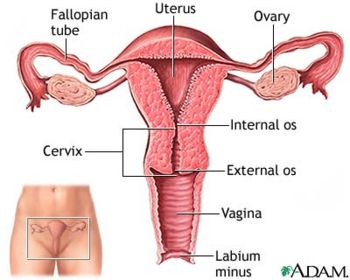
The vagina is located directly anterior to the anus and below the urethral opening. It is a muscular passageway which connects the uterus to the exterior genitals. Immediately outside the vaginal opening is the labia minora, which is also known as the inner lips, which then leads into the labia majora, the outer lips. Typically after puberty, the labia majora is covered with hair, otherwise known as mons pubis. All together, the labia minora, labia majora, clitoris, mons pubis, and vestibule is called the vulva. Neighboring parts surrounding the vagina also include the clitoris, urethral orifice, vestibule, and hymen. The clitoris is a hard round organ directly on top of the vulva and encircles and extends into the vagina. This organ is to supply pleasure during sexual intercourse and is at the anterior end joining the labia minora. The urethral orifice lies above the vagina and below the clitoris and functions to excrete urine stored in the urinary bladder. The hymen is a membrane which acts like a flap partially covering the opening of the vagina.
Physical Conditions
With an approximate pH value ranging from 3.8 to 4.5, the vagina functions in a relatively acidic environment. This pH range is required for a healthy vagina for protection purposes. Any pH value higher than 4.5 potentially leads to serious problems. The vagina is typically at or slightly above normal body temperature. This acidic environment is important to maintain so that certain pathogens can not cultivate in that area. But usually this is not an issue because the acidic environment makes it impossible for the pathogens to survive. It is important for moisture maintenance to prevent dryness and irritation. To the left and right of the vaginal opening are two oval shaped vestibular glands, otherwise known as Bartholon glands, which secrete mucous for lubrication purposes. During sexual arousal, these glands also secrete addition lubricants to prevent pain during intercourse. Throughout a woman’s life, there are fluctuations in the amount of estrogen produced in the body. Estrogen assures that the tissues surrounding the vagina retains elasticity and retains moisture. However, when a woman experiences menopause, estrogen levels decreases dramatically which ultimately leads to vaginal dryness, irritation, and decrease in tissue elasticity.
Influence by Adjacent Communities
Is your niche close to another niche or influenced by another community of organisms?
Conditions under which the environment changes
Do any of the physical conditions change? Are there chemicals, other organisms, nutrients, etc. that might change the community of your niche.
A mathematical model for kefiran production by Lactobacillus kefiranofaciens was established, in which the effects of pH, substrate and product on cell growth, exopolysaccharide formation and substrate assimilation were considered. The model gave a good representation both of the formation of exopolysaccharides (which are not only attached to cells but also released into the medium) and of the time courses of the production of galactose and glucose in the medium (which are produced and consumed by the cells). Since pH and both lactose and lactic acid concentrations differently affected production and growth activity, the model included the effects of pH and the concentrations of lactose and lactic acid. Based on the mathematical model, an optimal pH profile for the maximum production of kefiran in batch culture was obtained. In this study, a simplified optimization method was developed, in which the optimal pH profile was determined at a particular final fermentation time. This was based on the principle that, at a certain time, switching from the maximum specific growth rate to the critical one (which yields the maximum specific production rate) results in maximum production. Maximum kefiran production was obtained, which was 20% higher than that obtained in the constant-pH control fermentation. A genetic algorithm (GA) was also applied to obtain the optimal pH profile; and it was found that practically the same solution was obtained using the GA.
Microbes Present
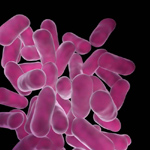
Lactobacillus is one of the main microorganisms responsible for maintaining a healthy vaginal flora. Its production of Lactic acid contribute to the vaginal acidic environment. There are different strains of Lactobacillus able to colonize the vaginal flora, however, those with maximal adherence to the epithelium such as Lactobacillus acidophilus help against bacterial vaginosis (BV) due to their hydrogen peroxide producing capabilities. Bacterial Vaginosis is caused when there is a lack of Lactobacillus in the vaginal flora, allowing various types of microbes to inhabit the environment leading to complications such as pelvic inflammatory disease and sexually transmitted diseases like HIV.
Current research is identifying the best strain of Lactobacillus in order to recolonize a healthy vaginal flora. McLean and Rosenstein studied several Lactobacillus strain in order to identify the best strain able to re-colonize the vaginal flora of women with BV. This strain should be able to produce sufficient H2O2, be able to inhibitory activity against BV bacteria, acid production, and have strong adherence ability to the vaginal epithelial cell (VEC). They found two strains of the L. acidophilus (61701 and 48101) to have such characteristics (2).
Sha et al. show a correlation between Lactobacillus and BV, however, an inverse correlation with HIV (1). Furthermore, BV bacteria have been shown to upregulate HIV expression. Therefore, by suntanning a healthy vaginal flora by preventing BV infections, Lactobacillus acidophilus can help combat sexually transmitted diseases. Also, Lactobacillus Hydrogen Peroxide has been shown to have virucidal effects allowing the vaginal flora to have some protection against pathogens (2).
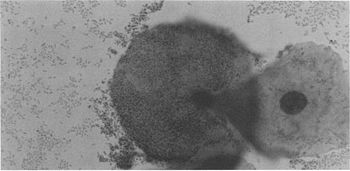
Gardnerella Vaginalis is one of the microorganisms that causes an infection of the vagina known as bacterial vaginosis. The infection is thought to be transmitted through sexual activity, but can also be found in women with no cases of sexually transmitted diseases. Douching and using intrauterine devices (IUDs) can also help lead to the cause of BV. When infected, the vagina secrets a gray or yellow discharge, which is often accompanied with a “fishy” smell. (4) Gardnerella vaginalis, along with other bacteria, inhabit the vagina and cause a chemical imbalance. These bacteria outnumber the amount of Lactobacillus found in the vagina, which are beneficial and essential to the vagina. (5)
Current research has shown that a type of Lactobacillus, Lactobacillus acidophilus, inhibits the growth of the bacteria Gardnerella Vaginalis. Aroutcheva, Simoes, and Faro performed experiments using two different methods in order to determine the effect of L. acidophilus on G. Vaginalis. Lactobacillus is an important microbe essential to keeping a healthy vaginal environment. Microbes such as G. Vaginalis, are detrimental to the vaginal environment and could cause infections such as bacterial vaginosis. L. acidophilus 160 was isolated from a healthy vaginal microflora, purified, and was then used differently in each experiment. One method required the inoculation of the L. acidophilus into defined media, and the other required the growth of the strain in MRS agar. The defined media method showed that the growth of G. Vaginalis was inhibited by substances found in the media in which the L. acidophilus was added to. The agar method showed that the growth of G. Vaginalis was inhibited by the bacteriocin, a protein produced by bacteria, that was released from the L. acidophilus 160 strain. (6)
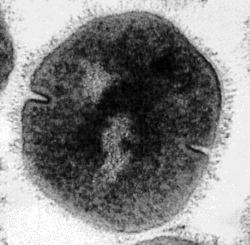
Group B Beta Streptococcus (S. Agalacitae)
S. agalactiae is a gram-positive, beta-hemolytic, opportunistic pathogenic coccus which colonizes the vaginal and gastrointestinal/rectal tract of healthy adults by adherence to surfaces of vaginal epithelial cells. The distal vagina is more frequently colonized than rectal sites in both pregnant and non-pregnant adults. The polysaccharide antiphagocytic capsule is the most prominent virulence factor as it binds maximally onto vaginal epithelial cells in the acidic pH levels of vaginal mucosa where attachment does not depend on capsular serotype or bacterial viability. [9] S. agalactiae is acquired by infants born to colonized mothers via vertical transmission in 29-72% of cases by a process involving the bacterium undergoing adherence to vaginal epithelial cells and resistance to mucosal immune defenses such as immunoglobulin A (IgA).[7] Once thought to be pathogens of domestic animals, S. agalactiae is the leading cause of neonatal sepsis in humans resulting in early-onset infections of pneumonia, septicemia and late-onset infections of meningitis or bacteremia.
S. agalactiae has a evolutionary relationship between the bacterium and the host [7]. There exists selective pressures for S. agalactiae interaction with host to establish colonization and ensure transmission to newly susceptible hosts(neonates). Host factors play a significant role in determining the pathogenic potentials of S. agalactiae.
Current research exhibit’s inhibition of uropathogenic microbes, specifically S. Agalactiae and G. vaginalis, by vaginal epithelial cell adherence of three strains of human vaginal lactobacilli ( L. acidophilus, l. gasseri, and l. jensenii) in vitro via receptor competition and co-aggregation. [10] Vaginal epithelial cells have glycolipid receptors which are targeted by both S. Agalactiae and lactobacillus. Lactobacilli inhibits the opportunistic pathogen S. Agalactiae by competing for receptors present on surfaces of vaginal epithelial cells and also by co-aggregating with uropathogenic bacteria to inhibit growth when antimicrobial compounds such as lactic acid and hydrogen peroxide are produced [10].
Other non-microbes present
Fungi:
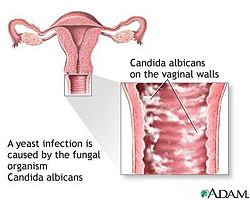
Fungi are eukaryotic organisms and their DNA is enclosed in a nucleus. Fungi are said to be "plant like", but fungi do not make their own food from sunlight like plants do. Fungi are very useful to humans as they have helped make antibiotics to fight bacterial infections. but can also be deadly that cause diseases and infections. Fungi come in a variety of shapes, sizes, and different types. They can range from enormous chains of cells that can stretch for miles or single individual cells.
Bacteria:
Bacteria consist of only a single cell but are amazingly complex. Bacteria have also been found that can live in temperatures above boiling point and well below freezing temperatures. They "eat" everything from sugar and starch to sunlight, sulfur, and iron. Bacteria have fallen into a category of life known as the Prokaryotes. Moreover, Prokaryotes' genetic material, or DNA, is not enclosed in a cellular compartment called the nucleus. Bacteria along with their microbial cousins the archaea were the earliest forms of life on Earth. They have played a vital role in shaping our planet into one that could support the larger forms of life through the process of photosynthesis.
Viruses:
A virus is a small bundle of genetic material (DNA or RNA) that is carried in a shell called the viral coat, or capsid, which is made up of bits of protein called capsomeres. However, viruses cannot metabolize nutrients, produce and excrete wastes, move around their own, or even reproduce unless they are inside another organism's cells. Ultimately, viruses are not even cells yet they have played key roles in shaping the history of life on our planet by shuffling and redistributing genes in and among organisms and by causing diseases in animals and plants.
Microbe interaction with each other
Describe any negative (competition) or positive (symbiosis) behavior
bacterial vaginosis and gardnerella vaginalis
Microbes environment change
Do they alter pH, attach to surfaces, secrete anything, etc. etc.
Metabolism that affects their environment
Do they ferment sugars to produce acid, break down large molecules, fix nitrogen, etc. etc.
Current Research
Antibiotic Susceptibility of Atobium Vaginae (2006 March 16)
Prior studies have shown that anaerobic bacterium, Atopobium vaginae had been closely related with Bacterial Vaginosis. There have only been four isolates of this fastidious organism that were found to be highly resistant to metroniadazole and susceptible for clindamycin, two antibiotics preferred for the treatment of Bacterial Vaginosis. The research group studied the susceptibility of nine other A. vaginae isolates for 15 antimicrobial agents by using the Etest and for comparison that included a limited number of other important vaginal bacteria such as lactobacilli, G. vaginalis, bifidobacteria and compared results from previously published articles. The decided method for this particular research involved nine strains of Atopobium vaginaw, four strains of Gardnerella vaginalis, two strains of Lactobacillus iners and one strain each of Bifidobacterium breve, B. Longum, L. Crispatus, L.gasseri and L. jensenii which were tested against 15 antimicrobial agents using the Etest. The conclusion of this research had shown Clindamycin had a higher activity against G. vaginalis and A. vaginae than metronidazole, but not all A. vaginae isolates are metronidazole resistant, that seemed to be an apparent conclusion from previous studies on a more limited number of strains. In addition, the research group had concluded Bacterial vaginosis as a polymicrobial disease and the organisms that were involved were likely to be in a symbiotic relationship to each other for various metabolic requirements. In conclusion, clindamycin was shown to dimish the vaginal colonisation resistancere. However, resistance to clindamycin seems to develop more readily than resistance to metronidazole which becomes apparent from clinical studies comparing both antibiotics.
Future studies will focus on determining the antibiotic suseptibility of the vaginal specie that will shed light to develop new regimens for treatment of recurrent bacterial vaginosis. An important note is to make clear whther this metronidazole resistance might be acquired by the presence and activation of nim-genes.
http://www.pubmedcentral.nih.gov/articlerender.fcgi?tool=pubmed&pubmedid=16542416 <----- (Im Working on summarizing this now - Jason T. Wong 8/25)
http://www.nature.com/ismej/journal/v1/n2/full/ismej200712a.html
References
(1)Female Genital-Tract HIV Load Correlates Inversely with Lactobacillus Species but Positively with Bacterial Vaginosis and Mycoplasma hominis Beverly E. Sha, M. Reza Zariffard, Qiong J. Wang, Hua Y. Chen, James Bremer, Mardge H. Cohen, and Gregory T. Spear The Journal of Infectious Diseases 2005 191:1, 25-32
(2) McLean, N. W., and I. J. Rosenstein. 2000 Characterisation and selection of a Lactobacillus species to re-colonise the vagina of women with recurrent bacterial vaginosis J. Med. Microbiol. 49 543–552
(3)The Identification of Vaginal Lactobacillus Species and the Demographic and Microbiologic Characteristics of Women Colonized by These Species May A. D. Antonio, Stephen E. Hawes, and Sharon L. Hillier The Journal of Infectious Diseases 1999 180:6, 1950-1956
(6) Aroutcheva, Alla A, Simoes, Jose A., and Faro Sebastian. 2001 Antimicrobial protein produced by vaginal Lactobacillus acidophilus that inhibits Gardnerella vaginalis
(7) Streptococcal infections : clinical aspects, microbiology, and molecular pathogenesis / edited by De New York : Oxford University Press, 2000. P. 223-230, 183-186.
(8) Contemporary therapy in obstetrics and gynecology / editors, Scott B. Ransom ... [et al.] Philadelphia : W.B. Saunders, c2002. p. 148-151.
(10) "Adherence of Human Vaginal Lactobacilli to Vaginal Epithelial Cells and Interaction with Pathogens"
Edited by [Jason Wong, Yumi Honda, Elieth Martinez, Raymond Villar, Eunice Kim, Whitney La], students of Rachel Larsen
